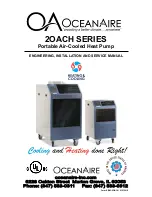
Locate the probable leak and seal it immediately. Use only original parts to
replace a defective refrigeration component.
Use only dehydrated nitrogen for detecting leaks or for pressurised tests.
Do not allow the refrigerant fluid to escape into the atmosphere.
1.5
Domestic water safety
In accordance with safety rules, a safety valve calibrated to 0.7 MPa (7
bar) is mounted on the tank's domestic cold water inlet.
A pressure reducer (not provided) is required when the supply pressure
exceeds 80% of the safety valve or safety unit calibration and must be
located upstream of the appliance.
There must be no cut-off devices between the safety valve or unit and the
domestic hot water tank.
The hydraulic installation must be capable of handling a minimum flow rate
at all times.
Heating water and domestic water must not come into contact with each
other. Domestic water must not circulate through the exchanger.
Limit temperature at the draw-off point: the maximum domestic hot water
temperature at the draw-off point is subject to special regulations in the
various countries in which the appliance is sold in order to protect the
user. These special regulations be observed when installing the appliance.
Take precautions with the domestic hot water. Depending on the heat
pump settings, the domestic hot water temperature may exceed 65°C.
In order to limit the risk of being scalded, a thermostatic mixing valve must
be installed on the domestic hot water flow pipes.
1.6
Hydraulic safety
When making the hydraulic connection, it is imperative that the standards
and corresponding local directives be respected.
If radiators are connected directly to the heating circuit: install a differential
valve between the indoor unit and the heating circuit.
Fit drainage valves between the indoor unit and the heating circuit.
Do not add any chemical products to the heating water without first
consulting a water treatment specialist. For example: antifreeze, water
softeners, products to increase or reduce the pH value, chemical additives
and/or inhibitors. These may cause faults in the heat pump and damage
the heat exchanger.
1.7
Recommendations for operation
The frost protection function does not work if the heat pump is switched
off.
If the home is unoccupied for a long period and there is a risk of frost,
drain the indoor unit and the heating system.
Keep the heat pump accessible at all times.
Never remove or cover the labels and data plates affixed to appliances.
Labels and data plates must be legible throughout the entire lifetime of the
appliance.
Immediately replace damaged or illegible instructions and warning
stickers.
Give preference to the OFF or frost protection mode rather than switching
off the system to leave the following functions running:
Anti blocking of pumps
Frost Protection
Regularly check the presence of water and pressure in the heating
system.
1 Safety instructions and recommendations
7748711 - v03 - 08062020
AWHP MIV-S
7








































